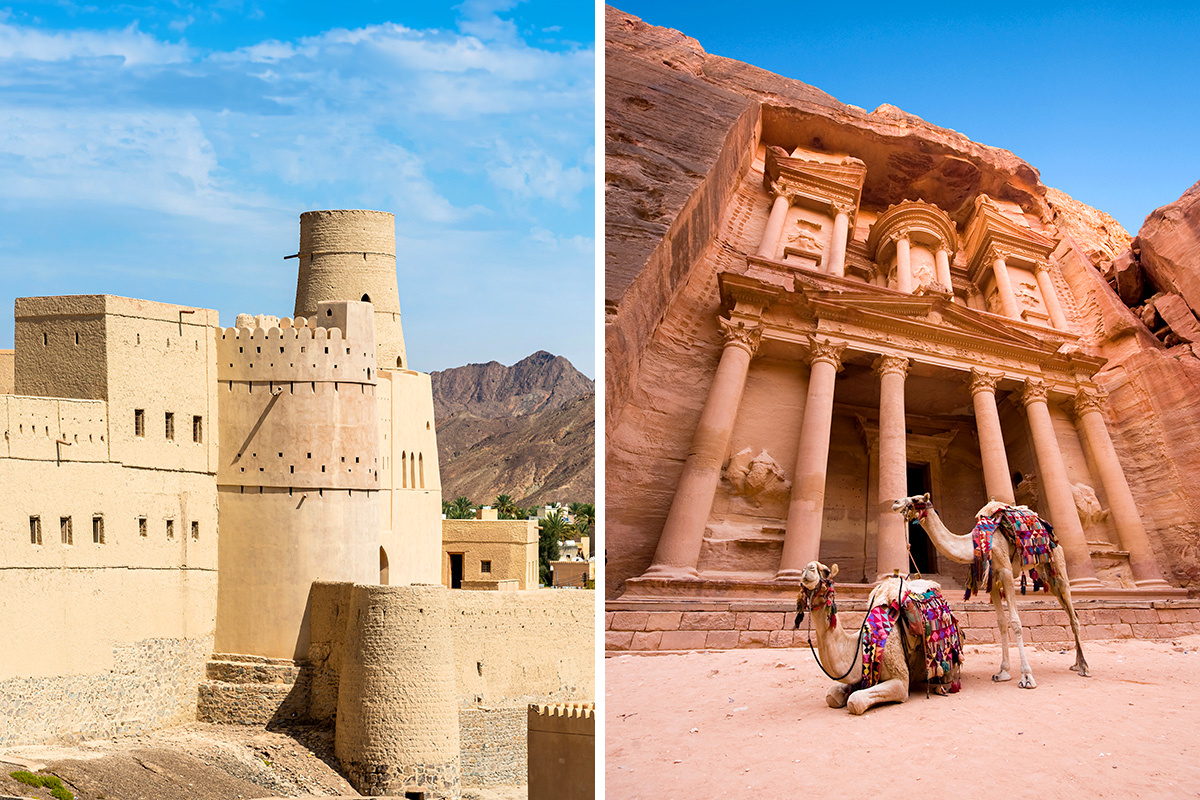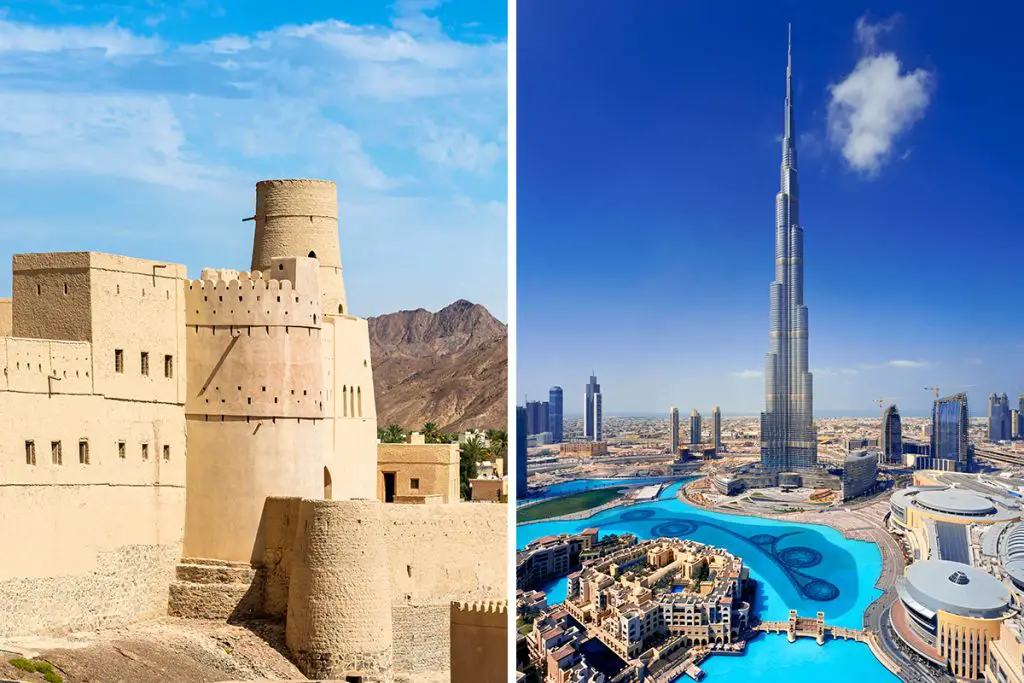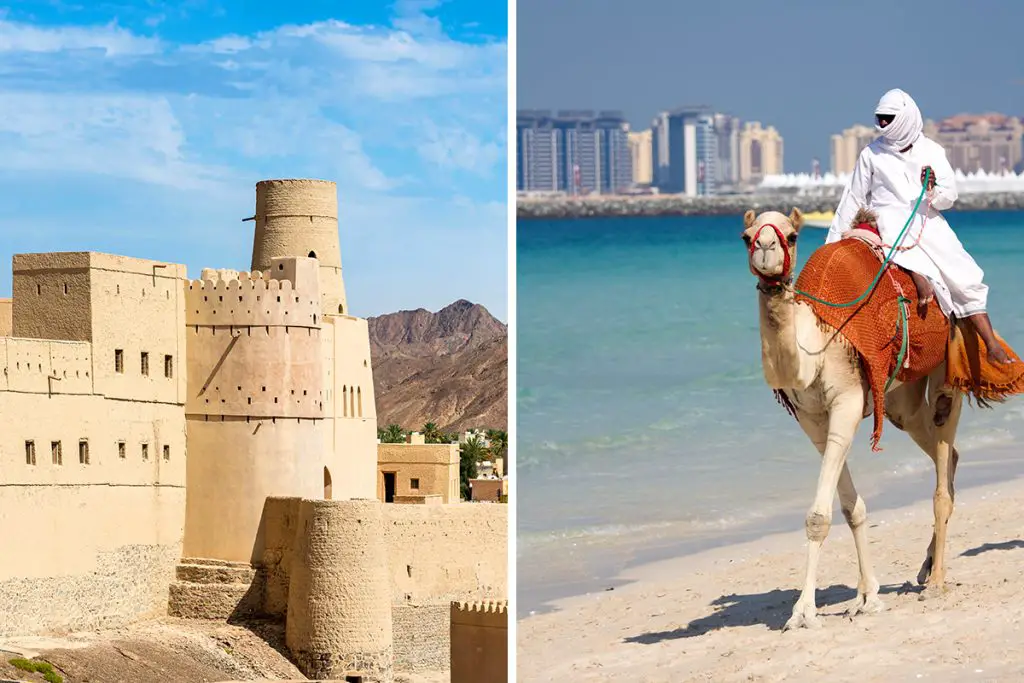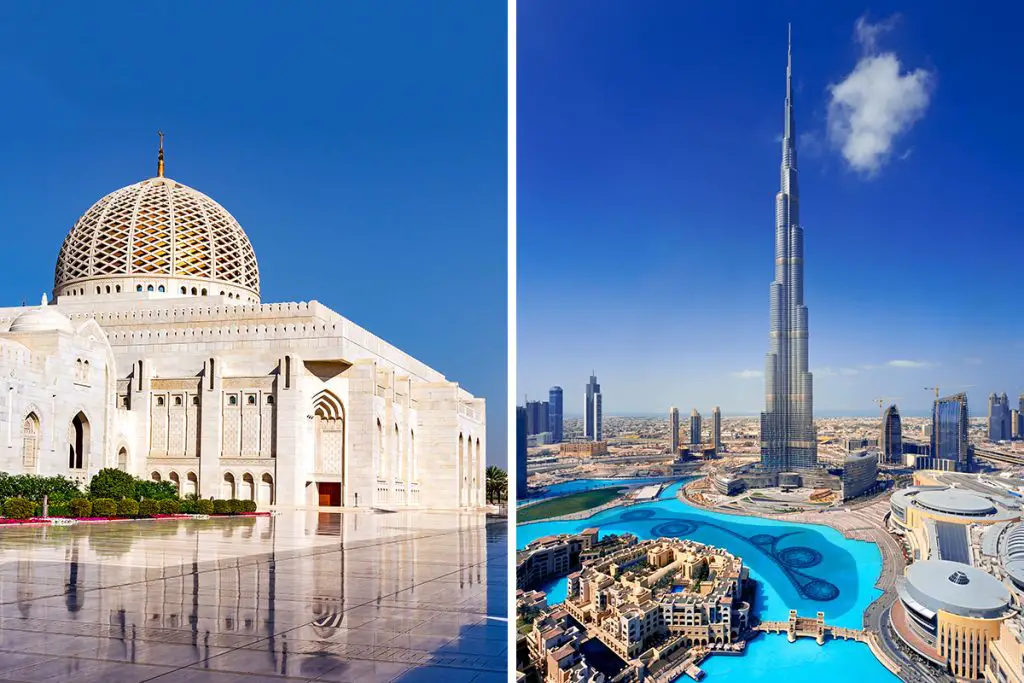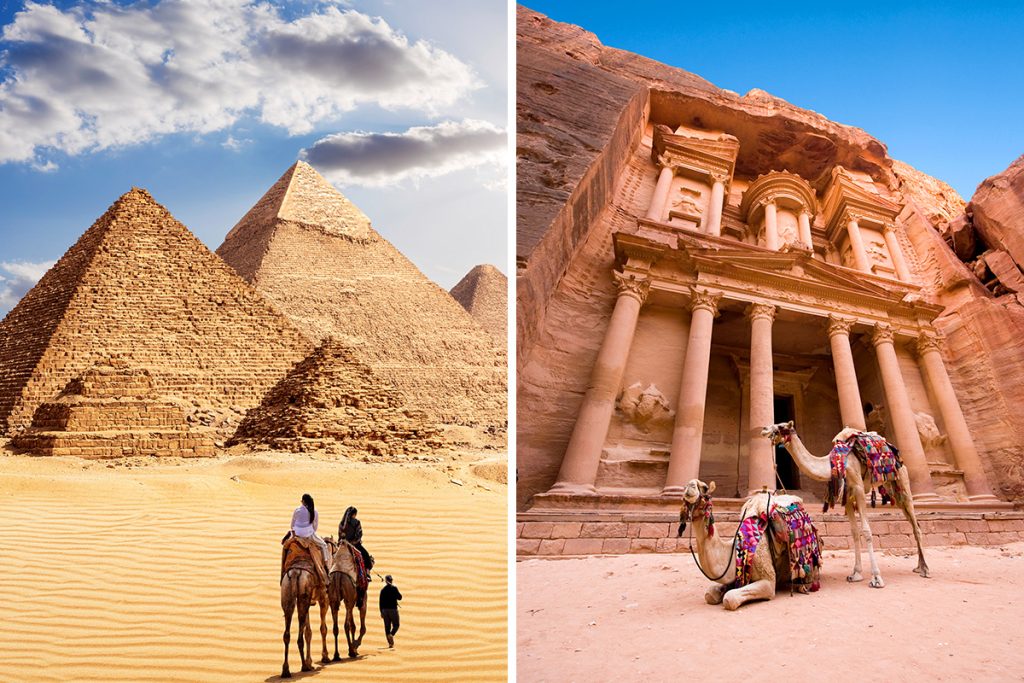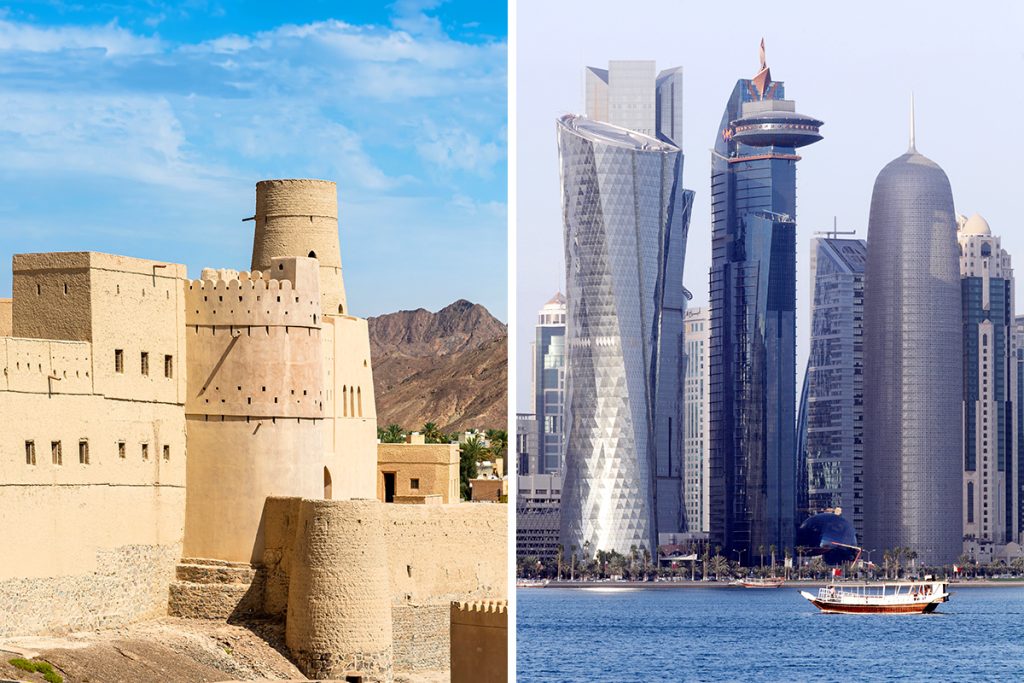Selecting between Oman and Jordan might be challenging given their unique allure. Both offer incredible experiences that stay with you long after your journey. But don’t worry; this comparison should help you make an informed choice. Curious to find out how these two Middle Eastern countries measure up? Keep reading.
History & Culture
When you’re drawn to the rich tapestry of history and culture, Oman and Jordan will not disappoint. These countries serve as windows to the ancient and modern Middle East, and choosing between the two can be as complex as the civilizations they’ve nurtured.
Oman’s history is steeped in maritime trade and the legacy of ancient civilizations like the Magan and Maqan. The influence of different cultures, including Portuguese and British colonial rule, is apparent but hasn’t overshadowed Omani tradition. Its unique form of Islam, Ibadi, plays a central role in daily life, offering a distinct sense of identity.
In contrast, Jordan boasts a vibrant history that includes some of the world’s oldest civilizations, such as the Nabataeans who built the city of Petra.
Unlike Oman, Jordan has seen more direct impacts from the Abrahamic religions, including significant Christian and Islamic sites. While its population is mostly Arab, the influence of surrounding nations and empires throughout history is palpable.
Both countries are similar in that they respect their past while embracing the future. Oman is slightly more conservative, reflected in the strict dress codes and social norms. Meanwhile, Jordan offers a bit more leniency in terms of westernization, as seen in its more relaxed dress codes and social interactions.
In summary, if you’re fascinated by maritime history and unique local customs, Oman will entice you. On the other hand, if ancient ruins and a melting pot of Middle Eastern cultures appeal to you, Jordan might be your ideal destination. Both countries provide a deep dive into the complex histories and diverse cultures of the Middle East.
Attractions & Activities
If you’re an adventure junkie or a history buff, Oman and Jordan offer an array of attractions and activities that cater to diverse interests. Both countries invite you to discover their unique landscapes and historical sites, making it difficult to choose between the two.
In Oman, get your adrenaline pumping by dune bashing in the expansive Wahiba Sands desert. These aren’t just any dunes; they tower as much as 100 meters (approximately 328 feet) high. Also, don’t miss out on exploring the Al Hajar Mountains, which provide hiking opportunities and stunning vistas.
For a more cultured experience, the Royal Opera House in Muscat is a must-visit for lovers of music and architecture.
Jordan, on the other hand, is home to the world-renowned Petra, one of the New Seven Wonders of the World. If you’re an avid hiker, the Dana Biosphere Reserve offers a range of hiking trails that allow you to explore the country’s diverse ecosystems.
Adventure seekers can also take part in canyoning in the Wadi Mujib gorge. The experience is unlike any other, as you navigate through the canyon’s waterfalls and rock formations.
Both countries offer splendid diving experiences but in contrasting settings. While Oman’s Daymaniyat Islands provide a marine landscape rich in coral and fish, Jordan presents the unique opportunity to go diving in the Red Sea, offering a glimpse of vibrant marine life and wrecks.
To sum it up, if your interests lean toward grand deserts and mountain ranges, Oman holds the ticket. However, if ancient ruins and diverse ecosystems pull at your heartstrings, Jordan would be the place to go. Each destination offers a unique set of attractions and activities that promise unforgettable memories.
Beaches
When it comes to sandy shores and crystal-clear waters, Oman and Jordan serve up some enviable options. These Middle Eastern countries, both boasting extensive coastlines, offer a range of beach experiences that are as different as they are captivating.
Oman’s coastline stretches about 3,165 kilometers (around 1,967 miles), and its beaches are known for their untouched beauty. Places like Al Bustan Beach offer serenity and seclusion, allowing you to unwind and soak up the sun. For snorkeling enthusiasts, Bandar Khayran is a fantastic spot where the water is teeming with marine life.
Jordan’s coastline, though shorter at approximately 26 kilometers (about 16 miles) along the Red Sea, is no less appealing. Aqaba is the main hub for beach activities in Jordan, and its waters are warm and inviting, making them ideal for various water sports like scuba diving and windsurfing.
While Oman offers more variety in terms of beach landscapes, such as rocky outcrops and serene bays, Jordan’s compact coastline concentrates high-quality beach experiences in a smaller area, like that in Aqaba, which is also closer to other attractions in the country.
In conclusion, if you’re looking for a wider range of beach experiences with more secluded options, Oman might be the way to go. However, if you prefer a compact and convenient beach experience that doesn’t compromise on quality, Jordan’s Aqaba could be more to your liking. Both destinations promise an exceptional coastal experience that you’ll remember for a lifetime.
Eating, Drinking & Nightlife
Food, drinks, and nightlife play an essential role in your travel experience. When it comes to Oman and Jordan, both offer distinct flavors and atmospheres that can either add spice or relaxation to your nights. The choice really depends on what you’re looking to get out of your evenings.
Omani cuisine features a rich blend of spices, meats, and rice, with dishes like shuwa and mashuai offering authentic local flavors. Restaurants here lean toward the traditional, with fewer international options compared to Jordan.
In Jordan, you’ll find a broader range of food options, including more international cuisines. Must-try dishes include mansaf, a bedouin dish, and falafel. For those with diverse palates, Jordan’s cities offer a medley of food choices that combine local traditions with global influences.
When it comes to drinking, Oman is a bit more conservative. Alcohol is available but mostly in hotels and private clubs. The local drink of choice is often coffee or tea flavored with cardamom. Jordan has a more liberal approach to alcohol, and you can find local beers and wines more easily, even in casual dining spots.
Nightlife in Oman is more subdued, focusing on family-friendly activities or quieter outings like visiting a café for traditional Omani tea. Jordan offers a more vibrant nightlife, especially in Amman, where you can find a range of bars and clubs that cater to different music tastes and social scenes.
All in all, if you’re seeking a subdued, culturally rich dining and evening experience, Oman might be the place for you. But if you’re after a wider variety of food options and a livelier evening atmosphere, Jordan holds the promise of unforgettable nights.
Shopping
Shopping can be a real treat or an exciting hunt for souvenirs that encapsulate your journey. Oman and Jordan offer distinctive shopping experiences that are both diverse and rich in culture.
In Oman, you’ll find traditional markets, called “souqs,” where you can purchase unique items like silverware, textiles, and fragrant frankincense. The Mutrah Souq in Muscat is particularly popular for tourists and locals alike. You’ll find it brimming with handmade crafts, spices, and traditional Omani garments.
Jordan’s shopping scene is more varied. From luxurious malls in Amman to bustling bazaars like the Amman Souq, the options are plentiful. You can get traditional items such as olive wood carvings or Dead Sea products, which are known for their skin benefits.
Rainbow Street in Amman provides a mix of contemporary boutiques and traditional shops, offering something for everyone.
If you’re into bargaining, both countries offer opportunities to hone your haggling skills, but you might find the atmosphere a bit more laid-back in Jordan’s markets compared to the bustling vibe of Oman’s souqs.
In summary, for a more traditional shopping experience with a focus on local crafts, Oman is your destination. However, if you prefer a mix of old and new, with more options to choose from, then Jordan should be at the top of your list.
Accommodation
Choosing the perfect place to stay is often a big part of planning your trip. Oman and Jordan both offer a range of accommodations that suit different needs, but there are some distinctions to consider.
Oman’s options are a bit more luxurious, generally speaking. High-end resorts like the Al Bustan Palace in Muscat or the Anantara in the Al Hajar Mountains offer opulence and stunning natural settings. For a more traditional experience, you can also stay in desert camps in Wahiba Sands, which offer a unique blend of comfort and adventure.
Jordan provides a diverse range of accommodations too but leans more towards boutique hotels and eco-lodges. Places like the Feynan Ecolodge in Dana Biosphere Reserve offer an off-the-grid experience that connects you with nature, while hotels in Amman offer more urban comforts. Bedouin camps in Wadi Rum offer a culturally immersive experience.
While both countries offer budget-friendly options, you might find more hostels and budget hotels in Jordan, particularly in tourist-heavy areas like Petra and Aqaba. Oman’s budget accommodations are often more basic and are usually situated in less central locations.
In summary, if you’re looking for luxurious settings and are willing to splurge, Oman could be more your speed. However, if you want a variety of options that include eco-friendly and budget stays, Jordan might be a better fit for you.
Family-Friendliness & Children’s Activities
When you’re traveling with family, especially kids, it’s essential to pick a destination that offers something for everyone. Oman and Jordan both present family-friendly environments but in unique ways.
Oman is generally more conservative, but it’s a very safe country with many resorts offering family-oriented activities. For example, the Shangri-La Barr Al Jissah Resort has multiple pools and offers dolphin-watching excursions that are sure to delight children.
Jordan is a bit more versatile when it comes to activities for kids. The country offers adventure camps, historical sites with interactive guides, and nature reserves that provide educational experiences. Locations like the Dana Biosphere Reserve often have family-friendly hiking trails and guided nature walks.
Both Oman and Jordan offer fantastic opportunities for camel rides. In Oman, you could book a family-friendly camel trek through the Wahiba Sands. Jordan offers similar experiences in the stunning backdrop of Wadi Rum.
While both countries have family-friendly dining options, Jordan often has a wider variety of foods that may be more familiar to younger palates, including fast food and pizzas, along with local cuisine.
In summary, both Oman and Jordan offer rich experiences that families can enjoy, but they cater to slightly different tastes. Oman is ideal for families looking for a more relaxed, resort-style vacation, while Jordan offers a wider variety of activities that can be educational as well as fun.
Getting There & Getting Around
Getting to your dream destination and exploring it conveniently is crucial. Both Oman and Jordan have their own sets of pros and cons when it comes to accessibility and local transport.
To get to Oman, you’d likely fly into Muscat International Airport, which is about 30 kilometers (around 18.6 miles) from the city center. For Jordan, Queen Alia International Airport near Amman is the main entry point, situated approximately 35 kilometers (about 21.7 miles) from downtown.
In terms of getting around, Oman is best navigated by car, especially if you’re planning to visit more remote areas. Public transport is limited. Jordan, on the other hand, has a more developed public transport system with reliable bus services connecting major cities and tourist destinations.
Oman has a lot of open space, so distances between attractions can be longer. You might find yourself driving for hours to get from one place to another. In Jordan, attractions are relatively closer, making it easier to explore more in a shorter amount of time.
Both countries offer taxis and ride-share services, but these are generally more cost-effective in Jordan. Oman’s taxis can get quite pricey, especially for longer journeys.
In conclusion, if you’re comfortable driving and don’t mind longer distances between attractions, Oman offers stunning landscapes that make the journeys worthwhile. Jordan, on the other hand, offers more convenience in terms of public transport and proximity of attractions, making it easier to move around and see more.
Weather
Weather often plays a crucial role in how much you’ll enjoy a destination. Knowing what to expect in terms of climate can help you plan your activities and wardrobe. Let’s dive into the weather details for Oman and Jordan.
Oman is typically hot and dry, especially during the summer months from May to September. Temperatures can soar up to 104°F (40°C) during these months. The winter months from November to March are milder, with daytime temperatures ranging from 68°F to 77°F (20°C to 25°C).
Jordan experiences a more diverse climate. Summers (June to September) are also hot, especially in the lowlands, but less humid compared to Oman, with temperatures ranging from 86°F to 104°F (30°C to 40°C). Winters (December to February) can be quite chilly, especially in Amman, with temperatures ranging between 39°F and 60°F (4°C to 16°C).
Both countries are dry, but Jordan receives more rainfall, particularly in the northern parts, during the winter months of November to March. Oman, on the other hand, is more susceptible to tropical storms, especially in the Dhofar region between June and September.
In summary, if you prefer hot and dry climates, either destination would suit you. However, for a bit of temperature variety and the possibility of experiencing some rainfall, Jordan might be your go-to.
Safety
When traveling, it’s crucial to consider safety—both in terms of crime rates and other factors like natural disasters. So, how do Oman and Jordan stack up?
Oman is generally regarded as one of the safest countries in the Middle East. Violent crime is extremely rare, and petty crime like pickpocketing is not common either. Police are helpful and responsive, making it a favorable destination for solo travelers.
Jordan is also quite safe but exercise a higher level of caution in crowded tourist areas where pickpocketing is more common. Nonetheless, the country has effective law enforcement and public safety is a priority.
Non-crime safety issues like road conditions are also noteworthy. Oman has well-maintained roads but a high rate of car accidents due to reckless driving. Jordan has less pristine road conditions but driving tends to be safer, particularly in rural areas.
In conclusion, both Oman and Jordan are generally safe destinations with low crime rates. Oman perhaps has the edge in terms of overall safety, but Jordan is also a strong contender. Road safety is a slight concern in Oman, but with cautious driving, it shouldn’t be a major issue.
Cost
Vacations can vary greatly in cost, depending on where you go. Let’s consider how your wallet might feel in Oman compared to Jordan.
Oman is generally on the more expensive side. A decent meal at a mid-range restaurant could cost you around 10 Omani Rials (approximately $26), and a night at a 3-star hotel might set you back $200. Transportation, especially if you’re renting a car, can also be pricey, with rentals averaging $40 per day.
Jordan is more budget-friendly. A good meal will usually cost you around 5–30 Jordanian Dinars (approximately $7 – $42), and comfortable 3-star hotels can be found for $150 per night. Public transportation is also cheaper, with bus fares usually under 1 Jordanian Dinar (approximately $1.41).
It’s also worth noting that entry fees to tourist attractions can be higher in Oman. For instance, the entrance fee to the Royal Opera House in Muscat is around 3-4 Omani Rials (approximately $7.80 – $10.40), whereas most historical sites in Jordan will charge an entry fee of around 5 Jordanian Dinars (approximately $7).
In summary, if cost is a significant factor for you, Jordan offers more bang for your buck. Oman provides a more luxurious experience but at a higher cost. Both offer unique experiences, but your budget might stretch further in Jordan.
Which Is Better – Oman or Jordan?
You’ve made it to the end of this journey exploring the delights and differences between Oman and Jordan. Let’s recap the various aspects that could influence your choice between these two remarkable Middle Eastern destinations.
In the realm of history and culture, both nations are incredibly rich, but they offer different experiences. Oman boasts a deep sense of traditionalism, whereas Jordan provides a diverse history that melds various cultural influences.
If an authentic Arabian experience is what you’re after, Oman takes the lead. But if you’re drawn to a melting pot of civilizations, Jordan is the spot for you.
When it comes to attractions and activities, both countries offer jaw-dropping landscapes and adventurous activities. However, Oman is more for the luxury-seeking traveler with its opulent opera houses and five-star desert camps. Jordan excels in historical landmarks, like Petra, making it perfect for the history buff or adventure seeker.
For beach lovers, Oman’s coastline is generally more secluded and offers a serene experience, ideal for relaxation. Jordan’s beaches, although fewer, are oriented more towards activities like snorkeling and diving. So, your choice would hinge on what type of beach experience you are looking for.
Eating, drinking, and nightlife brings us another set of contrasts. Oman is less geared towards a party atmosphere, and alcohol is relatively expensive. Jordan offers a more dynamic nightlife and is more liberal when it comes to drinking, making it the more versatile option for food and drink enthusiasts.
Shopping varies too; Oman is a haven for high-quality traditional crafts, while Jordan offers a mix of modern and traditional shopping experiences. Oman is ideal for those who are seeking unique, locally crafted items, whereas Jordan caters to a wider range of shopping preferences.
Both countries offer a wide range of accommodation options, with Oman leaning towards more luxurious stays and Jordan offering a broad range of budget-friendly options. Family-friendliness is somewhat equal in both, with Oman offering high-end family resorts and Jordan providing a wide range of activities for children.
The ease of getting there and getting around is roughly similar in both countries, with international airports and well-maintained roads. Oman does have a high rate of car accidents, so be cautious if you’re driving. Weather-wise, both are hot and dry, but Jordan offers a wider range of temperatures.
Safety levels are high in both countries, but Oman slightly edges out with lower crime rates. And finally, on the cost front, Jordan is generally more budget-friendly compared to the more luxurious, but expensive, options in Oman.
So when should you pick Oman over Jordan? Choose Oman if you’re seeking a luxurious, authentically Arabian experience, in a country that prides itself on safety and pristine beaches. Opt for Jordan if you’re on a budget, if you’re keen to explore a diverse range of historical sites, or if you’re looking for a more liberal eating and drinking culture.
Both Oman and Jordan offer unique experiences that can cater to a variety of preferences and budgets. Your ultimate choice depends on what you value most in your travel experiences.

